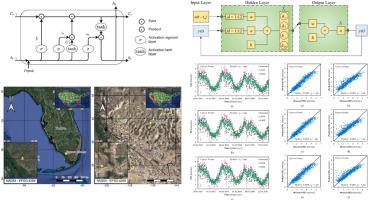Agricultural Water Management ( IF 5.9 ) Pub Date : 2021-06-26 , DOI: 10.1016/j.agwat.2021.107040 Francesco Granata , Fabio Di Nunno

|
Accurate ahead evapotranspiration forecasting is crucial for irrigation planning, for wetlands, agricultural and forest habitats preservation, and for water resource management. Deep learning algorithms can be used to develop effective forecasting models of ahead evapotranspiration. In this study, three Recurrent Neural Network-based models were built for the prediction of short term ahead actual evapotranspiration. Two variants of each model were developed changing the employed algorithm, selecting between long short-term memory (LSTM) and nonlinear autoregressive network with exogenous inputs (NARX), while the modeling was performed in the context of an ensemble approach. The prediction models were trained and tested using data from two sites with different climates: Cypress Swamp, southern Florida, and Kobeh Valley, central Nevada. With reference to the subtropical climatic conditions of South Florida, LSTM models proved to be more accurate than NARX models, while some exogenous variables such as sensible heat flux and relative humidity did not affect the results significantly. An increase of the forecast horizon from 1 to 7 days resulted in a slight reduction in the accuracy of both the LSTM- and NARX based models. Considering instead the semi-arid climate of Central Nevada, NARX models generally provided more accurate results, which were only slightly affected by relative humidity, sensible heat flux, and forecast horizon. On the other hand, LSTM models performance decayed if sensible heat flux and relative humidity were neglected, and if the forecast horizon was increased from 1 to 7 days. Deep learning-based models can provide very accurate predictions of actual evapotranspiration, but the performance of the models can be significantly affected by local climatic conditions.
中文翻译:

使用循环神经网络的集合预测不同气候下的蒸散量
准确的提前蒸散预测对于灌溉规划、湿地、农业和森林栖息地保护以及水资源管理至关重要。深度学习算法可用于开发有效的提前蒸散预测模型。在这项研究中,建立了三个基于循环神经网络的模型来预测短期的实际蒸散量。开发了每个模型的两个变体,改变了所采用的算法,在长短期记忆 (LSTM) 和具有外源输入的非线性自回归网络 (NARX) 之间进行选择,而建模是在集成方法的背景下进行的。预测模型使用来自两个不同气候地点的数据进行训练和测试:佛罗里达州南部的赛普拉斯沼泽和内华达州中部的科比谷。参考南佛罗里达州的亚热带气候条件,LSTM模型被证明比NARX模型更准确,而一些外生变量如感热通量和相对湿度对结果没有显着影响。预测范围从 1 天增加到 7 天导致基于 LSTM 和 NARX 的模型的准确性略有下降。相反,考虑到内华达州中部的半干旱气候,NARX 模型通常提供更准确的结果,其仅受相对湿度、感热通量和预测范围的影响很小。另一方面,如果忽略显热通量和相对湿度,并且如果预测范围从 1 天增加到 7 天,LSTM 模型的性能就会下降。











































 京公网安备 11010802027423号
京公网安备 11010802027423号